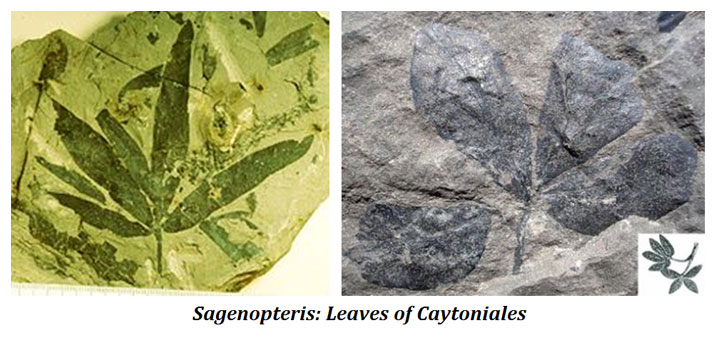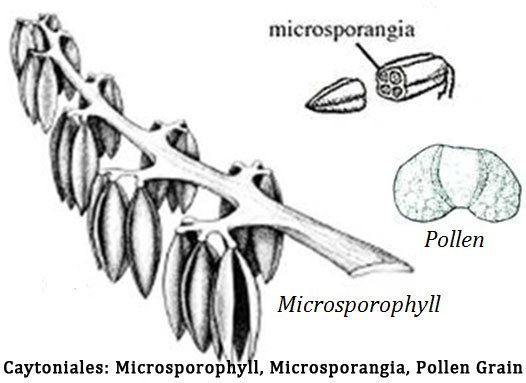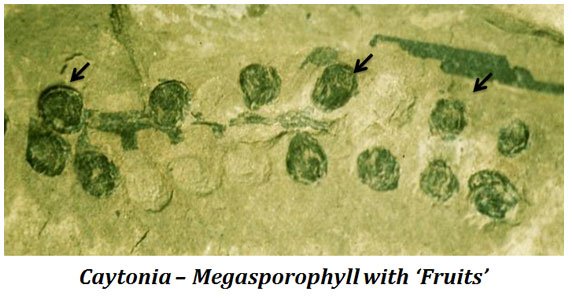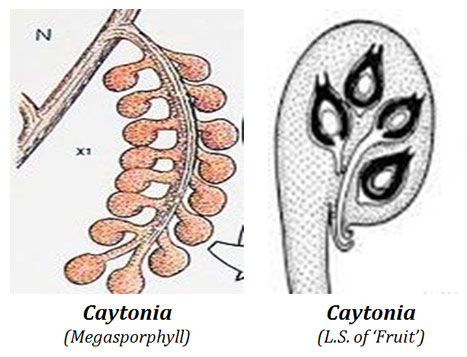What are Caytoniales?
Ø Caytoniales were a small group of extinct Gymnospermic plants.
Ø First described by Hamshaw Thomas in 1925 from the late Triassic period.
Ø Caytonia is a berry-like cupules with numerous small seeds.
Examples of Caytoniales
Ø Leaves: Sagenopteris
Ø Microsporophylls: Caytonanthus
Ø Megasporophylls: Caytonia and Gristhorpia
General Characteristics of Caytoniales
Ø Caytoniales were small branched trees or shrubs.
Leaves (Sagenopteris)
Ø Leaves petiolate
Ø Petiole slender with 3 to 6 terminal leaflets.
Ø Leaflets arrangement was palmate in pairs.
Ø Each leaflet with distinct midrib.

Ø Leaf margin smooth with an acute apex.
Ø Venation similar to Glossopteris
Learn more: General Characteristics of Glossopteridales
Ø Upper and lower epidermis with thick cuticle.
Ø Stomata were abundant on the lower surface of the leaf.
Ø Stomatal development haplocheilic.
Ø Mesophyll differentiated into palisade and transfusion tissue.
Ø Leaflets fall by the formation of abscission layers (it is an Angiospermic character).
Ø Caytoniales had fertile branches with seed-bearing cupules.
Ø Ovules were located inside the fleshy cupules with tough outer cuticle.
Ø Outer layers of the cupules were fleshy and fruit-like.
Ø Individual ovules had an apical tube like structure called micropylar canal.
Ø The micropylar canal facilitates the passage of pollen into the pollen chamber.
Ø Mature ovule resembles a blueberry fruit.
Ø The extra protection of seeds in Caytoniales indicates they were predecessors of Angiosperms.
Microsporophyll
Ø Example: Caytonanthus
Ø Microsporophyll consists of dorsi-vental and pinnate rachis.

Ø Each rachis bears pinnae on either side.
Ø Each pinnae branches irregularly.
Ø The ultimate branches of pinnae bear the synangia.
Ø Each branch bears two sporangia terminally.
Ø Each sporangium was with four pollen sacks.
Ø Pollen grains were produced in the pollen sacs in groups of four.
Ø Pollen grains were small, shape similar to that of pine trees.
Ø Pollen grains winged.
Ø Pollination is achieved through the wind.
Megasporophyll
Ø Example: Caytonia and Gristhorpia
Ø Megasporophylls were also pinnate.
Ø It consists of a dorsi-ventral rachis with a number of outgrowths.
Ø Outgrowths were staked and with swollen tips (like berries).

Ø These outgrowths were called the “Fruits”.
 Ø The swollen portion of the rachis contains many ovules internally.
Ø The swollen portion of the rachis contains many ovules internally.
Ø After maturation, the ‘fruits’ also fall by abscission (like leaves).
Ø Fruits surface smooth.
Ø Sees were pendulous, orthotropous, oval or flattened.
| You may also like... | ||
|---|---|---|
| NOTES | QUESTION BANK | COMPETITIVE EXAMS. |
| PPTs | UNIVERSITY EXAMS | DIFFERENCE BETWEEN.. |
| MCQs | PLUS ONE BIOLOGY | NEWS & JOBS |
| MOCK TESTS | PLUS TWO BIOLOGY | PRACTICAL |
You might also like…
@. Glossopteridales – General Characteristics
@. Pteridospermales – General Characteristics
@. Gymnosperms – General Characteristics
@. Gymnosperms – Classification

Bacillariophyta
Bacillariophyta k bre me batye n please